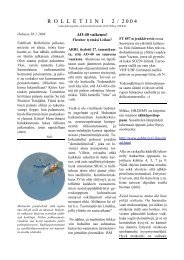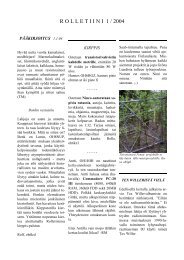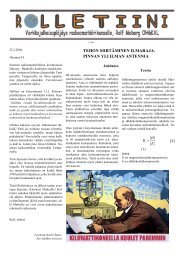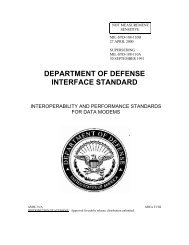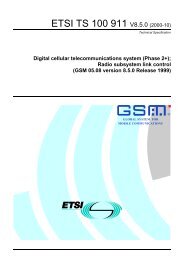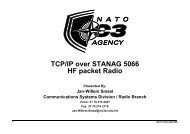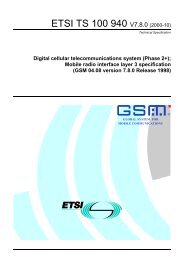nato unclassified - Ham-pages ... No indexes at this level
nato unclassified - Ham-pages ... No indexes at this level
nato unclassified - Ham-pages ... No indexes at this level
Create successful ePaper yourself
Turn your PDF publications into a flip-book with our unique Google optimized e-Paper software.
NATO UNCLASSIFIED<br />
STANAG 5066: PROFILE FOR MARITIME HF DATA COMMUNICATION<br />
V1.0.2<br />
Direction :<br />
Client-> Subnetwork Interface<br />
Subnetwork Interface-> Client<br />
Description :<br />
This primitive can be issued as required (e.g. during periods of inactivity) by the<br />
clients and/or the Subnetwork Interface to sense whether the physical connection<br />
between the client and the Subnetwork is alive or broken. This primitive may be<br />
redundant if the implement<strong>at</strong>ion of the physical connection provides an implicit<br />
mechanism for sensing the st<strong>at</strong>us of the connection. When <strong>this</strong> primitive is received,<br />
the client or node shall respond with the same primitive within 10 seconds. If a reply<br />
is not sent within 10 seconds, no reply shall be sent. A client or node shall not send<br />
<strong>this</strong> primitive more frequently than once every 120 seconds to the same destin<strong>at</strong>ion.<br />
Name :<br />
S_HARD_LINK_ESTABLISH<br />
Arguments :<br />
1. Link Priority<br />
2. Link Type<br />
3. Remote <strong>No</strong>de Address<br />
4. Remote SAP ID<br />
Direction :<br />
Client-> Subnetwork Interface<br />
Description :<br />
This primitive is used by a client to request the establishment of a Hard Link between<br />
the local <strong>No</strong>de to which it is connected and a specified remote <strong>No</strong>de. A Hard Link<br />
can only be termin<strong>at</strong>ed by the client who requested it, or by another client on either<br />
end of the Link by requesting a Hard Link of a higher priority than the existing one.<br />
Physical Links between <strong>No</strong>des are normally made and broken unil<strong>at</strong>erally by the HF<br />
subnetwork according to the destin<strong>at</strong>ions of the queued U_PDUs. Such links are<br />
classified as Soft Links. The S_HARD_LINK_ESTABLISH primitive, allows a<br />
client to override these procedures and request a Physical Link to be made to a<br />
specific <strong>No</strong>de and be maintained until the client decides to break it. The argument<br />
Link Priority defines the priority of the Link. It can take a value in the range 0-3.<br />
Hard Link requests made by higher Ranked clients shall take precedence over<br />
requests of lower Ranked clients regardless of the value of the Link Priority<br />
argument. The Link Type argument can be used by the requesting client to fully or<br />
partially reserve the bandwidth of the Link. It can take a value in the range 0-2. The<br />
Link Type argument is further discussed <strong>at</strong> the end of <strong>this</strong> section. The Remote <strong>No</strong>de<br />
Address argument specifies the physical HF <strong>No</strong>de Address to which a connection<br />
must be established and maintained. The Remote SAP ID argument identifies the<br />
single client connected to the remote <strong>No</strong>de, to and from which traffic is allowed. This<br />
argument is only valid if the Link Type argument has a value of 2 (see discussion <strong>at</strong><br />
the end of <strong>this</strong> section for clarific<strong>at</strong>ion).<br />
Name :<br />
S_HARD_LINK_TERMINATE<br />
Arguments :<br />
1. Remote <strong>No</strong>de Address<br />
Direction :<br />
Client-> Subnetwork Interface<br />
Description :<br />
NATO UNCLASSIFIED<br />
12




